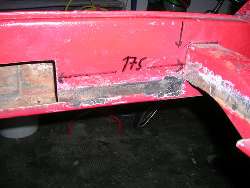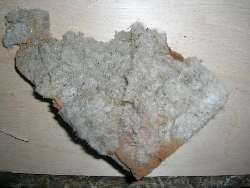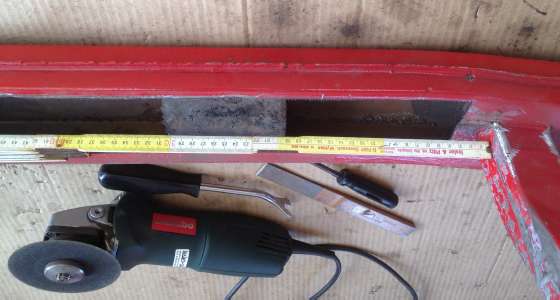The MGA With An Attitude
Frame CLEANING, Watch Out for the STUFFING - FR-105
Frame welding repairs are fairly straight forward, being thicker gauge metal, structural stuff, and mostly hidden after assembly (not a cosmetic problem except for concours show). If you do any cut and patch work on the frame side rails you may notice some mineral wool stuffing material inside. This is primarily for sound deadening to suppress ringing vibration and acoustical echo inside the tubes. Leave this stuff in place as much as you can. It is heat resistant to tolerate the original welding processes, so it should not be burned out during your welding repairs.


Thanks to Thomas Furtwaengler (in Baden-Württemberg, Germany) for these pictures. The pictures show a cut out of the inboard side of left frame rail, and the mineral wool stuffing found inside. The stuffing is commonly located just aft of the square cross tube, as shown in the picture.

The frame box sections are fairly well sealed up with original construction, except for a few small drain holes in the bottom of the side rails. Rust mostly attacks the outer surfaces of the frame, sometimes to the point of perforation (especially along the floorboards). The hidden inner surfaces of the frame tubes are usually not much affected by rust, except where it gets through from the outside. Notice the clean inside surfaces of the 50 year old frame even though the inboard side was perforated along the floorboard area.
When my car was 20 years old I patched a few minor perforation holes along the floorboards, then cleaned and painted the accessible surfaces. Now another 25 years and 240,000 more miles on the road in all kinds of weather, and the frame is still solid. I am a firm believer that there is no need to put any kind of metal preservative inside of the MGA frame. Then again, I may be proven wrong if mine might rust out 50 years after I am dead.
Perhaps the mineral wool may not have been used from the very beginning of production. I have never had my frame opened up enough to look inside in that area. The packing is obviously not needed to make the car functional, but it does show that the makers were conscientious about sound level in these cars. Another example is the later production gearbox having thicker bolt flange and more ribbing on the bell housing, not for strength but to reduce resonance vibration and noise.
The mineral wool is actually a very good material for the intended objective. It drains well (like wire wool) so it will not hold moisture for any prolonged period of time. Obviously the frame seldom has much moisture inside, as it does not rust much from the inside. The mineral wool allows welding for initial production, and also is no problem for later welding repairs. If it was my choice, I'd leave the mineral wool in there to retain original sound deadening quality of the car as a whole. However, any attempt to paint inside the frame would likely gum up the wool and add weight, and may also defeat the ventilation properties that keep it dry inside. There is likely no way to paint inside the frame rails and then replace the mineral wool afterward.
 As a side note, I have installed 3/8 inch thick carpet padding on all of the tunnel and floor (not frame rails) from just under the goalpost (including the fame closure plate) to aft of the seats. I have also installed the "under dash pad" from Moss Motors for thermal and acoustical insulation under the heater shelf and on rear side of the upper bulkhead. This setup is phenomenally good at reducing intrusion of engine noise and heating of the passenger compartment (also good for retaining heat in cold weather). It works so well that I almost installed an under bonnet pad to reduce tappet noise.
As a side note, I have installed 3/8 inch thick carpet padding on all of the tunnel and floor (not frame rails) from just under the goalpost (including the fame closure plate) to aft of the seats. I have also installed the "under dash pad" from Moss Motors for thermal and acoustical insulation under the heater shelf and on rear side of the upper bulkhead. This setup is phenomenally good at reducing intrusion of engine noise and heating of the passenger compartment (also good for retaining heat in cold weather). It works so well that I almost installed an under bonnet pad to reduce tappet noise.
Once welding repairs are finished it is good to mechanically clean the frame using wire wheel, sanding, Scotch-Brite buffing or sand blasting. You can use chemical paint stripper applied to visible surfaces, and rubbing with wire wool may help to remove old paint. Keeping the frame mostly right side up during chemical stripping is a good idea to reduce intrusion of chemicals inside through the bottom side drain holes. It is a BAD IDEA to drill holes and have the frame chemically dipped for any reason. If you did that the fiber packing material inside the side rails would tend to hold the chemicals inside rather than draining out, and that could cause chemical leaching and outer surface paint problems later. It is okay if you want to drill small holes to facilitate internal application of some corrosion inhibitor like Waxoil. If you do that I would advise plugging the holes with plastic snap plugs after painting.
|



